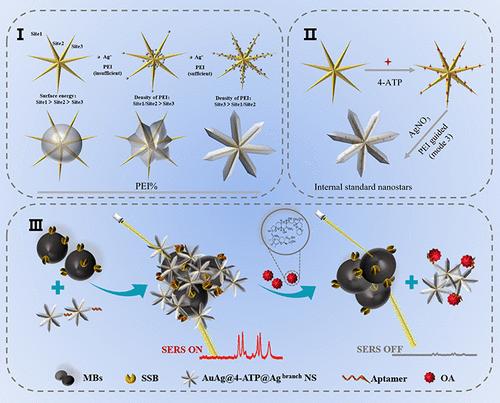Our official English website, www.x-mol.net, welcomes your
feedback! (Note: you will need to create a separate account there.)
Controlled Spread of a Ag Layer from the Core to the Tip along the Branches of AuAg Nanostars for Improved SERS Detection of Okadaic Acid in Shellfish
ACS Sensors ( IF 8.2 ) Pub Date : 2024-08-14 , DOI: 10.1021/acssensors.4c01539 Yun-Le Li 1 , Jian Zhu 1 , Guo-Jun Weng 1 , Jian-Jun Li 1 , Jun-Wu Zhao 1
ACS Sensors ( IF 8.2 ) Pub Date : 2024-08-14 , DOI: 10.1021/acssensors.4c01539 Yun-Le Li 1 , Jian Zhu 1 , Guo-Jun Weng 1 , Jian-Jun Li 1 , Jun-Wu Zhao 1
Affiliation

|
Plasmonic Au–Ag nanostars are excellent surface-enhanced Raman scattering (SERS) probes due to bimetallic coupling and the tip effect. However, the existing preparation methods of AuAg nanostars cannot achieve controlled growth of the Ag layer on the branches of nanostars and so cannot display their SERS to the maximum extent, thus limiting its sensitivity in biosensing. Herein, a novel strategy “PEI (polyethylenimine)-guided Ag deposition method” is proposed for synthesizing AuAg core–shell nanostars (AuAg@Ag NS) with a tunable distribution of the Ag layer from the core to the tip, which offers an avenue for investigating the correlation between SERS efficiency and the extent of spread of the Ag layer. It is found that AuAg@Ag NS with a Ag layer coated the whole branch has the strongest SERS performance because the coupling between the tips and Ag layer is maximized. Meanwhile, as a completely closed core–shell structure, AuAg@Ag NS can confine and anchor 4-ATP inside the Ag layer to avoid an unstable SERS signal. By connecting the aptamer, a reliable internal standard nanoprobe with a SERS enhancement factor (EF) up to 1.86 × 108 is prepared. Okada acid is detected through competitive adsorption of this SERS probes, and the detection limit is 36.6 pM. The results gain fundamental insights into tailoring the nanoparticle morphologies and preparation of internal standard nanoprobes and also provide a promising avenue for marine toxin detection in food safety.
中文翻译:

银层沿着金银纳米星的分支从核心到尖端的受控扩散,以改进贝类中冈田酸的 SERS 检测
由于双金属耦合和尖端效应,等离激元金银纳米星是优异的表面增强拉曼散射 (SERS) 探针。然而,现有的AuAg纳米星的制备方法无法实现纳米星分支上银层的可控生长,因此无法最大程度地展示其SERS,从而限制了其在生物传感中的灵敏度。在此,提出了一种新的策略“PEI(聚乙烯亚胺)引导银沉积方法”用于合成金银核壳纳米星(AuAg@Ag NS),其银层从核心到尖端的分布可调,为合成金银核壳纳米星(AuAg@Ag NS)提供了一条途径用于研究 SERS 效率与 Ag 层扩散程度之间的相关性。结果发现,整个分支上涂有银层的 AuAg@Ag NS 具有最强的 SERS 性能,因为尖端和银层之间的耦合最大化。同时,作为完全封闭的核壳结构,AuAg@Ag NS可以将4-ATP限制和锚定在Ag层内,以避免不稳定的SERS信号。通过连接适体,制备了可靠的内标纳米探针,其SERS增强因子(EF)高达1.86×10 8 。通过该SERS探针的竞争吸附来检测冈田酸,检测限为36.6 pM。研究结果为定制纳米粒子形态和内标纳米探针的制备提供了基本见解,并为食品安全中的海洋毒素检测提供了一条有前景的途径。
更新日期:2024-08-14
中文翻译:

银层沿着金银纳米星的分支从核心到尖端的受控扩散,以改进贝类中冈田酸的 SERS 检测
由于双金属耦合和尖端效应,等离激元金银纳米星是优异的表面增强拉曼散射 (SERS) 探针。然而,现有的AuAg纳米星的制备方法无法实现纳米星分支上银层的可控生长,因此无法最大程度地展示其SERS,从而限制了其在生物传感中的灵敏度。在此,提出了一种新的策略“PEI(聚乙烯亚胺)引导银沉积方法”用于合成金银核壳纳米星(AuAg@Ag NS),其银层从核心到尖端的分布可调,为合成金银核壳纳米星(AuAg@Ag NS)提供了一条途径用于研究 SERS 效率与 Ag 层扩散程度之间的相关性。结果发现,整个分支上涂有银层的 AuAg@Ag NS 具有最强的 SERS 性能,因为尖端和银层之间的耦合最大化。同时,作为完全封闭的核壳结构,AuAg@Ag NS可以将4-ATP限制和锚定在Ag层内,以避免不稳定的SERS信号。通过连接适体,制备了可靠的内标纳米探针,其SERS增强因子(EF)高达1.86×10 8 。通过该SERS探针的竞争吸附来检测冈田酸,检测限为36.6 pM。研究结果为定制纳米粒子形态和内标纳米探针的制备提供了基本见解,并为食品安全中的海洋毒素检测提供了一条有前景的途径。































 京公网安备 11010802027423号
京公网安备 11010802027423号